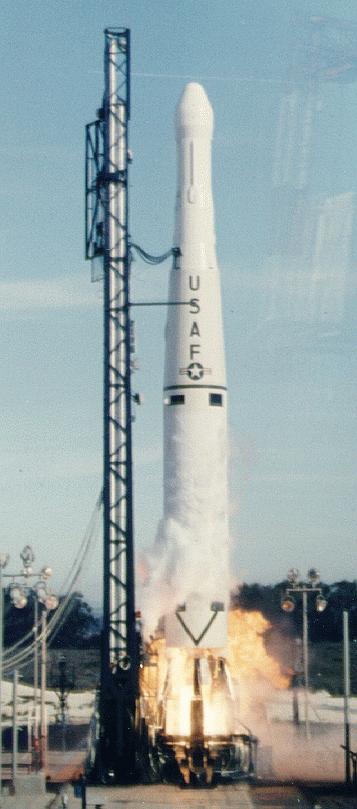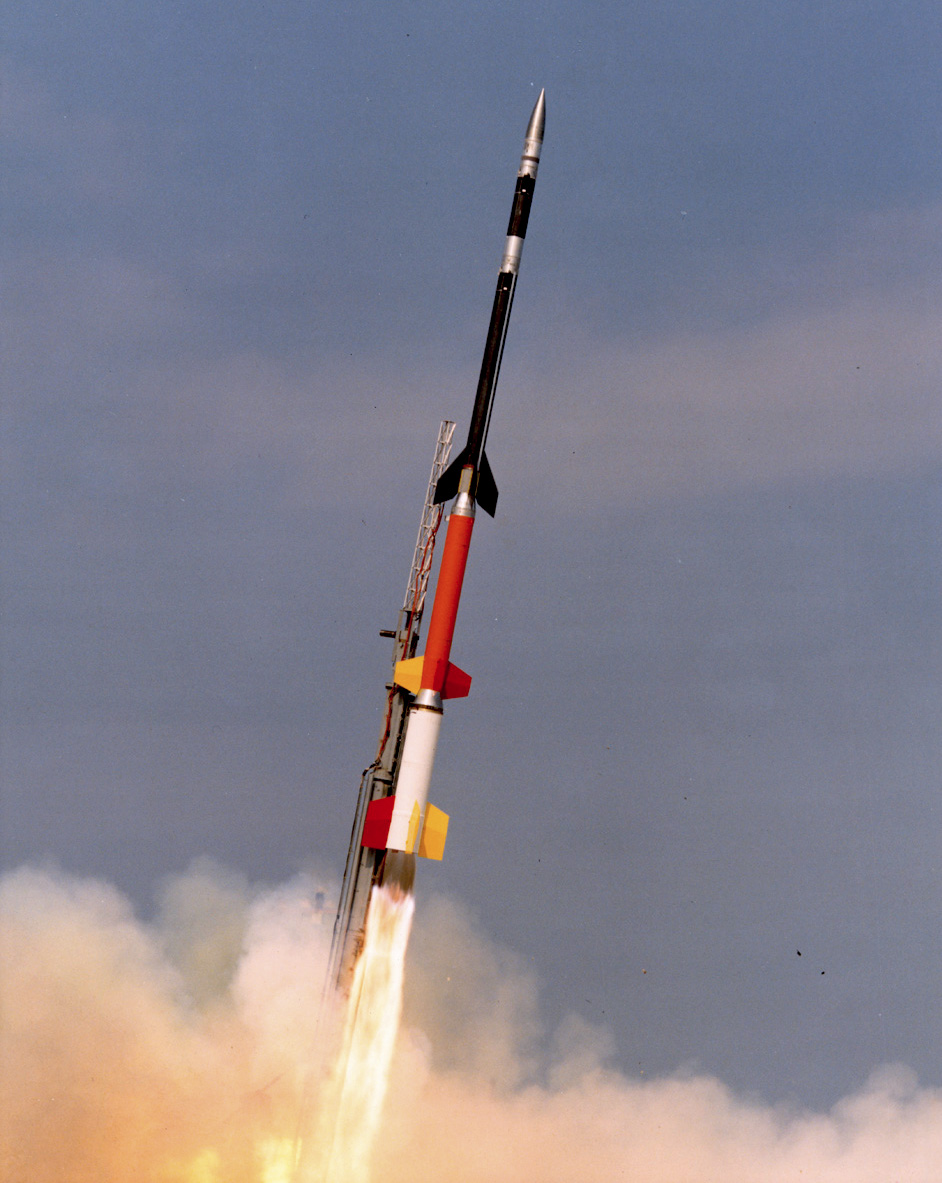|
Thor DSV-2
The Thor DSV-2 was a series of sounding rockets, test vehicles, and anti-satellite weapons derived from the PGM-17 Thor, Thor Intermediate-range ballistic missile. It was also used as the first stage of several Thor (rocket family), Thor-derived expendable launch systems. Variants Thor DSV-2A The DSV-2A was a two-stage rocket, consisting of a DSV-2A / MB-3-II first stage, and an Able-Star / AJ10-104D second stage. It was launched eight times between 1963 and 1965 from Vandenberg Space Force Base, Vandenberg. Thor DSV-2D The DSV-2D was launched twice in 1962, conducting suborbital research flights for the development of the Program 437 ASAT. It was a single-stage vehicle, consisting of a Thor DM-21. Launches were conducted from Cape Canaveral Air Force Station Cape Canaveral Air Force Station Launch Complex 17, Launch Complex 17A. Thor DSV-2E The DSV-2E was a single-stage vehicle, using a Thor DM-19. It was launched eight times in 1962, including several nuclear weapons test ... [...More Info...] [...Related Items...] OR: [Wikipedia] [Google] [Baidu] |
Sounding Rocket
A sounding rocket or rocketsonde, sometimes called a research rocket or a suborbital rocket, is an instrument-carrying rocket designed to take measurements and perform scientific experiments during its sub-orbital flight. The rockets are often used to launch instruments from above the surface of the Earth, the altitude generally between weather balloons and satellites; the maximum altitude for balloons is about and the minimum for satellites is approximately . Due to their suborbital flight profile, sounding rockets are often much simpler than their counterparts built for orbital flight. Certain sounding rockets have an apogee between , such as the Black Brant X and XII, which is the maximum apogee of their class. For certain purposes, sounding rockets may be flown to altitudes as high as to allow observing times of around 40 minutes to provide geophysical observations of the magnetosphere, ionosphere, thermosphere, and mesosphere. Etymology The origin of the term comes fr ... [...More Info...] [...Related Items...] OR: [Wikipedia] [Google] [Baidu] |
Calsphere
List of passive satellites is a listing of inert or mostly inert satellites, mainly of the Earth. This includes various reflector type satellites typically used for geodesy and atmospheric measurements. Passive satellites *Calsphere **Calsphere 1A **Calsphere 2 **Calsphere 3 **Calsphere 4 **Calsphere 4A **Calsphere 5 *Dragsphere 1 *Dragsphere 2 *Enoch *Explorer 9 *GFZ-1 *Humanity Star * LCS-1 * PAGEOS *PAMS-STU, see STS-77 *POPACS *Reflector *PasComSat *Rigid Sphere 1 (AVL-802H) *Rigid Sphere 2 *Sfera Dedicated laser ranging satellites Mostly passive satellites * Starshine 3 *Echo project **Echo 1 (Echo 1A) **Echo 2 * Elon Musk's Tesla Roadster *Hayabusa2 **Deployable camera 3 (DCAM3) **Small Carry-On Impactor (SCI) **Target Marker B **Target Marker A **Target Marker E (Explorer) **Target Marker C (Sputnik/Спутник) * Tianwen-1 ** Tianwen-1 Deployable Camera 1 ** Tianwen-1 Remote Camera **Tianwen-1 Deployable Camera 2 See also * List of laser ranging satellites *L ... [...More Info...] [...Related Items...] OR: [Wikipedia] [Google] [Baidu] |
X-20 Dyna-Soar
The Boeing X-20 Dyna-Soar ("Dynamic Soarer") was a United States Air Force (USAF) program to develop a spaceplane that could be used for a variety of military missions, including aerial reconnaissance, bombing, space rescue, satellite maintenance, and as a space interceptor to sabotage enemy satellites. The program ran from October 24, 1957, to December 10, 1963, cost US$660 million ($ in current dollars), and was cancelled just after spacecraft construction had begun. Other spacecraft under development at the time, such as Mercury or Vostok, were space capsules with ballistic re-entry profiles that ended in a landing under a parachute. Dyna-Soar was more like an aircraft. It could travel to distant targets at the speed of an intercontinental ballistic missile, was designed to glide to Earth like an aircraft under the control of a pilot, and could land at an airfield. Dyna-Soar could also reach Earth orbit, like conventional, crewed space capsules. These characteristics m ... [...More Info...] [...Related Items...] OR: [Wikipedia] [Google] [Baidu] |
ASSET (spacecraft)
ASSET, or Aerothermodynamic Elastic Structural Systems Environmental Tests was an experimental US space project involving the testing of an uncrewed sub-scale reentry vehicle. Development and testing Begun in 1960, ASSET was originally designed to verify the superalloy heat shield of the X-20 Dyna-Soar prior to full-scale crewed flights. The vehicle's biconic shape and low delta wing were intended to represent Dyna-Soar's forward nose section, where the aerodynamic heating would be the most intense; in excess of an estimated 2200 °C (4000 °F) at the nose cap. Following the X-20 Dyna-Soar programs' cancellation in December 1963, completed ASSET vehicles were used in reentry heating and structural investigations with hopes that data gathered would be useful for the development of future space vehicles, such as the Space Shuttle. Flights Built by McDonnell, each vehicle was launched on a suborbital trajectory from Cape Canaveral's Pad 17B at speeds of up to 6000&nb ... [...More Info...] [...Related Items...] OR: [Wikipedia] [Google] [Baidu] |
ASSET THOR
In financial accounting, an asset is any resource owned or controlled by a business or an economic entity. It is anything (tangible or intangible) that can be used to produce positive economic value. Assets represent value of ownership that can be converted into cash (although cash itself is also considered an asset). The balance sheet of a firm records the monetaryThere are different methods of assessing the monetary value of the assets recorded on the Balance Sheet. In some cases, the ''Historical Cost'' is used; such that the value of the asset when it was bought in the past is used as the monetary value. In other instances, the present fair market value of the asset is used to determine the value shown on the balance sheet. value of the assets owned by that firm. It covers money and other valuables belonging to an individual or to a business. ''Total assets'' can also be called the ''balance sheet total''. Assets can be grouped into two major classes: tangible assets and inta ... [...More Info...] [...Related Items...] OR: [Wikipedia] [Google] [Baidu] |
Bluegill Triple Prime
Operation Dominic was a series of 31 nuclear test explosions ("shots") with a total yield conducted in 1962 by the United States in the Pacific. This test series was scheduled quickly, in order to respond in kind to the Soviet resumption of testing after the tacit 1958–1961 test moratorium. Most of these shots were conducted with free fall bombs dropped from B-52 bomber aircraft. Twenty of these shots were to test new weapons designs; six to test weapons effects; and several shots to confirm the reliability of existing weapons. The Thor missile was also used to lift warheads into near-space to conduct high-altitude nuclear explosion tests; these shots were collectively called Operation Fishbowl. Operation Dominic occurred during a period of high Cold War tension between the United States and the Soviet Union, since the Cuban Bay of Pigs Invasion had occurred not long before. Nikita Khrushchev announced the end of a three-year moratorium on nuclear testing on 30 August 19 ... [...More Info...] [...Related Items...] OR: [Wikipedia] [Google] [Baidu] |
Bluegill (nuclear Test)
Operation Fishbowl was a series of high-altitude nuclear explosion, high-altitude nuclear tests in 1962 that were carried out by the United States as a part of the larger Operation Dominic I and II, Operation Dominic nuclear test program. Introduction The Operation Fishbowl nuclear tests were originally to be completed during the first half of 1962 with three tests named ''Bluegill, Starfish'' and ''Urraca''. The first test attempt was delayed until June. Planning for Operation Fishbowl, as well as many other nuclear tests in the region, began rapidly in response to the sudden Soviet Union, Soviet announcement on August 30, 1961, that they were ending a three-year moratorium on nuclear testing. The rapid planning of very complex operations necessitated many changes as the project progressed. All of the tests were to be launched on missiles from Johnston Island in the Pacific Ocean north of the equator. Johnston Island had already been established as a launch site for United ... [...More Info...] [...Related Items...] OR: [Wikipedia] [Google] [Baidu] |
Nuclear Warhead
A nuclear weapon is an explosive device that derives its destructive force from nuclear reactions, either fission (fission or atomic bomb) or a combination of fission and fusion reactions (thermonuclear weapon), producing a nuclear explosion. Both bomb types release large quantities of energy from relatively small amounts of matter. Nuclear bombs have had yields between 10 tons (the W54) and 50 megatons for the Tsar Bomba (see TNT equivalent). Yields in the low kilotons can devastate cities. A thermonuclear weapon weighing as little as can release energy equal to more than 1.2 megatons of TNT (5.0 PJ). Apart from the blast, effects of nuclear weapons include firestorms, extreme heat and ionizing radiation, radioactive nuclear fallout, an electromagnetic pulse, and a radar blackout. The first nuclear weapons were developed by the Allied Manhattan Project during World War II. Their production continues to require a large scientific and industrial complex, primari ... [...More Info...] [...Related Items...] OR: [Wikipedia] [Google] [Baidu] |
Operation Dominic I And II
Operation Dominic was a series of 31 nuclear test explosions ("shots") with a total yield conducted in 1962 by the United States in the Pacific. This test series was scheduled quickly, in order to respond in kind to the Soviet resumption of testing after the tacit 1958–1961 test moratorium. Most of these shots were conducted with free fall bombs dropped from B-52 bomber aircraft. Twenty of these shots were to test new weapons designs; six to test weapons effects; and several shots to confirm the reliability of existing weapons. The Thor missile was also used to lift warheads into near-space to conduct high-altitude nuclear explosion tests; these shots were collectively called Operation Fishbowl. Operation Dominic occurred during a period of high Cold War tension between the United States and the Soviet Union, since the Cuban Bay of Pigs Invasion had occurred not long before. Nikita Khrushchev announced the end of a three-year moratorium on nuclear testing on 30 Augus ... [...More Info...] [...Related Items...] OR: [Wikipedia] [Google] [Baidu] |
Nuclear Weapon
A nuclear weapon is an explosive device that derives its destructive force from nuclear reactions, either fission (fission or atomic bomb) or a combination of fission and fusion reactions (thermonuclear weapon), producing a nuclear explosion. Both bomb types release large quantities of energy from relatively small amounts of matter. Nuclear bombs have had yields between 10 tons (the W54) and 50 megatons for the Tsar Bomba (see TNT equivalent). Yields in the low kilotons can devastate cities. A thermonuclear weapon weighing as little as can release energy equal to more than 1.2 megatons of TNT (5.0 PJ). Apart from the blast, effects of nuclear weapons include firestorms, extreme heat and ionizing radiation, radioactive nuclear fallout, an electromagnetic pulse, and a radar blackout. The first nuclear weapons were developed by the Allied Manhattan Project during World War II. Their production continues to require a large scientific and industrial complex, pr ... [...More Info...] [...Related Items...] OR: [Wikipedia] [Google] [Baidu] |







